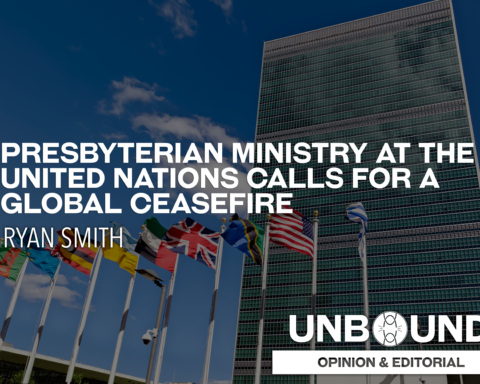A version of this article was originally published by the Austin American Statesmant at http://www.mystatesman.com/news/news/opinion/barstow-do-we-have-the-collective-will-to-end-the-/nrMcx/?icmp=statesman_internallink_referralbox_free-to-premium-referral. This new version is published with permission.

The HIV and AIDS epidemic is now more than three decades old. Almost 35 million people have died from AIDS-related causes. Fortunately, at a critical juncture fifteen years ago, the world responded to the crisis. Without that response, the toll would have been much worse. Because of that response, fifteen million people are now receiving life-preserving medication.
The PC(USA) was part of that global response, through the creation of a special World Mission office dedicated to AIDS-related activities, through the Presbyterian AIDS Network, and through the approval, by the 219th General Assembly (2010), of a policy statement designed to assist the PC(USA) in becoming an HIV and AIDS competent church. This concept was explored more fully by the World Council of Churches in the 2008 Ecumenical HIV & AIDS Initiative in Africa (EHAIA) handbook, Beacons of Hope: HIV Competent Churches – A Framework for Action.
The epidemic is now at another critical juncture. It is vital that the world respond again and that PC(USA) again be part of the response. Thanks to advances in science and medicine, we have the knowledge to end HIV and AIDS as public health threats by 2030. However, if we do not take full advantage of that knowledge, the disease will come roaring back in the 2020s, reaching infection and death rates reminiscent of the early days of the AIDS epidemic.
___________________________________________
If we act now, we can prevent 28 million people from becoming needlessly infected with HIV.
___________________________________________
 These two different futures are described in a recent epidemiological study by UNAIDS and The Lancet, a leading medical journal. The key results of the study are illustrated in the slide to the left. The chart shows the number of new HIV infections per year, looking back to 2010 and ahead to the year 2030. The blue area shows what will happen if we in the global community fully apply the knowledge at our disposal: the number of new infections will decline from about two million per year currently to about two hundred thousand per year by 2030. The red area shows what will happen if we don’t fully apply our knowledge: the number of new infections will start to rise again, reaching 2.5 million by 2030.
These two different futures are described in a recent epidemiological study by UNAIDS and The Lancet, a leading medical journal. The key results of the study are illustrated in the slide to the left. The chart shows the number of new HIV infections per year, looking back to 2010 and ahead to the year 2030. The blue area shows what will happen if we in the global community fully apply the knowledge at our disposal: the number of new infections will decline from about two million per year currently to about two hundred thousand per year by 2030. The red area shows what will happen if we don’t fully apply our knowledge: the number of new infections will start to rise again, reaching 2.5 million by 2030.
The difference between these two futures is 28 million people. If we act now, we can prevent 28 million people from becoming needlessly infected with HIV.
___________________________________________
There are about seventeen million people living with HIV who are not receiving therapy, many of whom are in groups that are marginalized by society.
___________________________________________
The epidemiological study also showed that we have a critical window of opportunity in the next five years. If the world makes the right global commitments now – and follows through with the right actions between now and 2020 – then we will indeed be on the path toward finally ending AIDS as a public health threat.

What role can the PC(USA) play in the global response at this critical juncture? What can we do during the next five years? I believe it comes down to two things:
- Be a voice of advocacy and moral urgency on the global stage
- Provide help and support to local church leaders who are fighting stigma
The agenda for the global response during this window of opportunity will largely be established at the High Level Meeting on AIDS, to be held at the United Nations from June 8 through June 10. The PC(USA) has been working with other faith-based groups in the process leading up to this meeting to emphasize the moral urgency of acting now and to advocate for sufficient resources to take full advantage of the scientific and medical advances. It will be important for the PC(USA) to continue to be a voice of advocacy to help ensure that the right actions follow the commitments made at the United Nations.
___________________________________________
The most important thing for faith communities to do is to reach out to the marginalized with messages of inclusion, to ensure that they can be tested and treated without fear.
___________________________________________
However, the second role of the PC(USA) listed above is perhaps even more important. Social issues, including stigma and discrimination, are important drivers of the epidemic. There are about seventeen million people living with HIV who are not receiving therapy, many of whom are in groups that are marginalized by society. These people are afraid of the social reaction if they get tested and if they begin treatment; they are afraid of what their neighbors will say or what their employers or other authorities will do.

Faith leaders have the social influence to change this situation. The authors of the UNAIDS-Lancet report have said that the most important thing for faith communities to do is to reach out to the marginalized with messages of inclusion, to ensure that they can be tested and treated without fear.
This is where the PC(USA) can, and must, help. Our partner denominations are the on-the-ground troops in the battle against the stigma of HIV and AIDS around the world, especially in Sub-Saharan Africa, and they need our support. It is a hard battle, but it can be won. I have spent much of the last decade working with local pastors in southern Africa, and I have seen the transformations these faith leaders can bring about: stigma disappears and their congregations become places of hope for people living with HIV. With support from the PC(USA) there can be many more places of hope, and perhaps at last the paralyzing grip of stigma will be defeated.
As we know from Luke 4:16-21, Christ came for marginalized:
[Jesus] went to Nazareth, where he had been brought up, and on the Sabbath day he went into the synagogue, as was his custom. He stood up to read, and the scroll of the prophet Isaiah was handed to him. Unrolling it, he found the place where it is written:
“The Spirit of the Lord is on me,
because he has anointed me to proclaim good news to the poor.
He has sent me to proclaim freedom for the prisoners
and recovery of sight for the blind, to set the oppressed free,
to proclaim the year of the Lord’s favor.”Then he rolled up the scroll, gave it back to the attendant and sat down. The eyes of everyone in the synagogue were fastened on him. He began by saying to them, “Today this scripture is fulfilled in your hearing.”

Christ’s earthly mission was devoted to the poor, the sick, the outcasts. Following his lead, and recognizing the moral urgency of taking action, the PC(USA) must do its part in the global response to the HIV and AIDS epidemic at this critical juncture. We must act with a particular emphasis on advocacy, stigma reduction, and support for our partner denominations. The intent of Overture 11-07, submitted for consideration by the 222nd General Assembly in Portland, is to ensure that PC(USA) does exactly that.
*****
AUTHOR BIO: Dr. David Barstow is a ruling elder at Westlake Hills Presbyterian Church in Austin, Texas. After a forty-year career in computer technology, he felt a call to change directions and has spent much of the last decade helping local pastors in southern Africa fight the stigma of HIV and AIDS. He can be contacted at [email protected].






Unbound Social